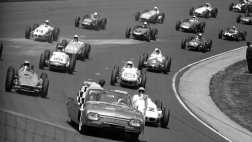Aston Martin has a rich and prestigious heritage and that the company is now 100 years old is one of the more remarkable feats of automotive longevity. Despite near death financial experiences on numerous occasions and more owners and investors than you and I have had hot dinners, Aston Martin is still there.
Other UK marques, such as Austin, Morris, Riley, Hillman, Singer, Humber, Sunbeam, Alvis, Jensen, Armstrong Siddley, Standard and Triumph have all disappeared, but Aston Martin lives on.
Founded in 1913 by Robert Bamford and Lionel Martin as ‘Bamford & Martin Ltd’, the company has developed into a global brand synonymous with speed, luxury and elegance. The name ‘Aston Martin’ came about when Lionel Martin successfully raced at the Aston Hill Climb in Buckinghamshire, England.
Financial problems plagued the company over the next decade (nothing new there) with the business forced to close in 1925. It was rescued by a group of investors in 1926. The business was soon producing a range of sports cars and had an increasing reputation for engineering and design.
Now remember, we are talking about a small niche player here, not some huge manufacturing conglomerate. A mere 140 cars were sold in 1937, the highest in the pre World War 2 era.
In 1947 a new owner took over, Sir David Brown, and it was during his watch that the most iconic Aston of all time was produced. I speak, of course, of the car frequently acclaimed as the most beautiful car in the world, the Aston Martin DB5-the one James Bond drove in Goldfinger.
Released in 1963, which means it's celebrating its 50 anniversary, the DB5 has come to personify everything that Aston Martin is today. Mind you, I think the most striking Aston Martin of all is the 1976 four door Lagonda. Designed by William Towns, it is an aggressively styled automobile.
Long of hood and short of tail, with a cutting edge computerized digital instrument panel, the Lagonda created a huge wave of publicity for the company. Nothing worked properly, of course. All those complex electronics just refused to operate as intended. Some folk unkindly suggested that an essential part of the car's tool kit was a multi-meter, O scope and jumper leads.
With an initial production rate of just one a week only 645 cars were built before the end of production in 1989. There are one or two still roaming this sunburnt country and about 80 in the UK.
David Burrell is the editor of Retroautos.com.au




.jpg)
.jpg)







.jpg)
.jpg)
.jpg)




.jpg)
.jpg)
.jpg)








Comments